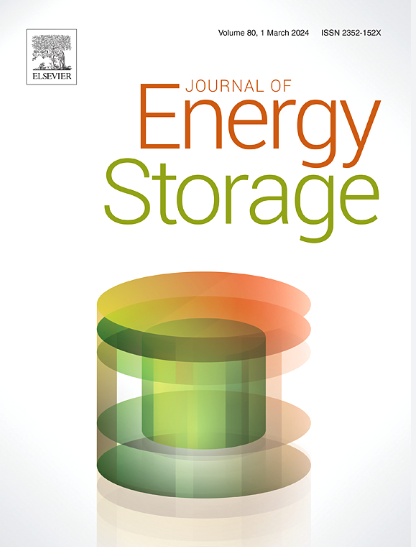多温度响应相变木塑复合材料与增强的热和机械性能的可持续建筑材料
IF 8.9
2区 工程技术
Q1 ENERGY & FUELS
引用次数: 0
摘要
全球气候变暖导致的极端温度波动和不断增长的能源需求对材料的热管理能力提出了更高的要求。为了实现双温度响应(20-50℃),我们利用高岭土纳米管(HNTs)的管状结构,通过界面凝聚和静电自组装在微胶囊表面构建了具有特殊蛛网结构的相变热层,从而制备了新型MicroPCMs (H-MicroPCMs)。h - micropcm具有优异的储热性能(ΔHm = 146.3 J/g)和形状稳定性。双重温度响应增强了它们对可变热条件的适应性,有助于提高实际应用中的能源效率,如气候响应材料和节能建筑系统。此外,在多温度响应木塑复合材料(H-WPCs)中,H-MicroPCMs表面的蜘蛛网结构形成了连续的热链接。h - wpc40(含40% H-MicroPCMs)的导热系数和储能效率分别提高55.01%和84.64%。同时,h - micropcm的蛛网相变层增强了PBAT与木粉之间的界面附着力,使h - wpc40的抗弯强度提高25.62%,抗弯模量提高133.40%。因此,H-WPC为应对全球气候变化引起的极端天气状况提供了一种创新的解决方案。它在节能建筑材料和智能建筑系统方面具有巨大的潜力,提高木材加工残留物的利用价值,在促进绿色建筑和可持续发展方面发挥着至关重要的作用。本文章由计算机程序翻译,如有差异,请以英文原文为准。
Multi-temperature responsive phase-change wood-plastic composites with enhanced thermal and mechanical properties for sustainable building materials
The extreme temperature fluctuations and growing energy demand caused by global climate warming have placed higher demands on the thermal management capabilities of materials. To achieve a dual temperature response (20–50 °C), we utilized the tubular structure of halloysite nanotubes (HNTs) and constructed a phase-change thermal layer with a special spider-web structure on the surface of the microcapsules through interface condensation and electrostatic self-assembly, thus preparing novel MicroPCMs (H-MicroPCMs). H-MicroPCMs exhibit excellent thermal storage (ΔHm = 146.3 J/g) and shape stability. The dual temperature response enhances their adaptability to variable thermal conditions, contributing to improved energy efficiency in practical applications such as climate-responsive materials and energy-saving building systems. Furthermore, the spider-web structure on the surface of H-MicroPCMs formed continuous thermal link in multi-temperature-responsive wood-plastic composites (H-WPCs). The thermal conductivity and energy storage efficiency of H-WPC 40 (with 40 % H-MicroPCMs) increased by 55.01 % and 84.64 %, respectively. Meanwhile, the spider-web phase-change layer of H-MicroPCMs enhanced the interfacial adhesion between PBAT and wood powder, resulting in a 25.62 % increase in bending strength and a 133.40 % increase in bending modulus of H-WPC 40. Therefore, H-WPC offers an innovative solution to address extreme weather conditions caused by global climate change. It holds significant potential for energy-efficient building materials and smart building systems, enhancing the utilization value of wood processing residues and playing a crucial role in promoting green buildings and sustainable development.
求助全文
通过发布文献求助,成功后即可免费获取论文全文。
去求助
来源期刊

Journal of energy storage
Energy-Renewable Energy, Sustainability and the Environment
CiteScore
11.80
自引率
24.50%
发文量
2262
审稿时长
69 days
期刊介绍:
Journal of energy storage focusses on all aspects of energy storage, in particular systems integration, electric grid integration, modelling and analysis, novel energy storage technologies, sizing and management strategies, business models for operation of storage systems and energy storage developments worldwide.
 求助内容:
求助内容: 应助结果提醒方式:
应助结果提醒方式:


